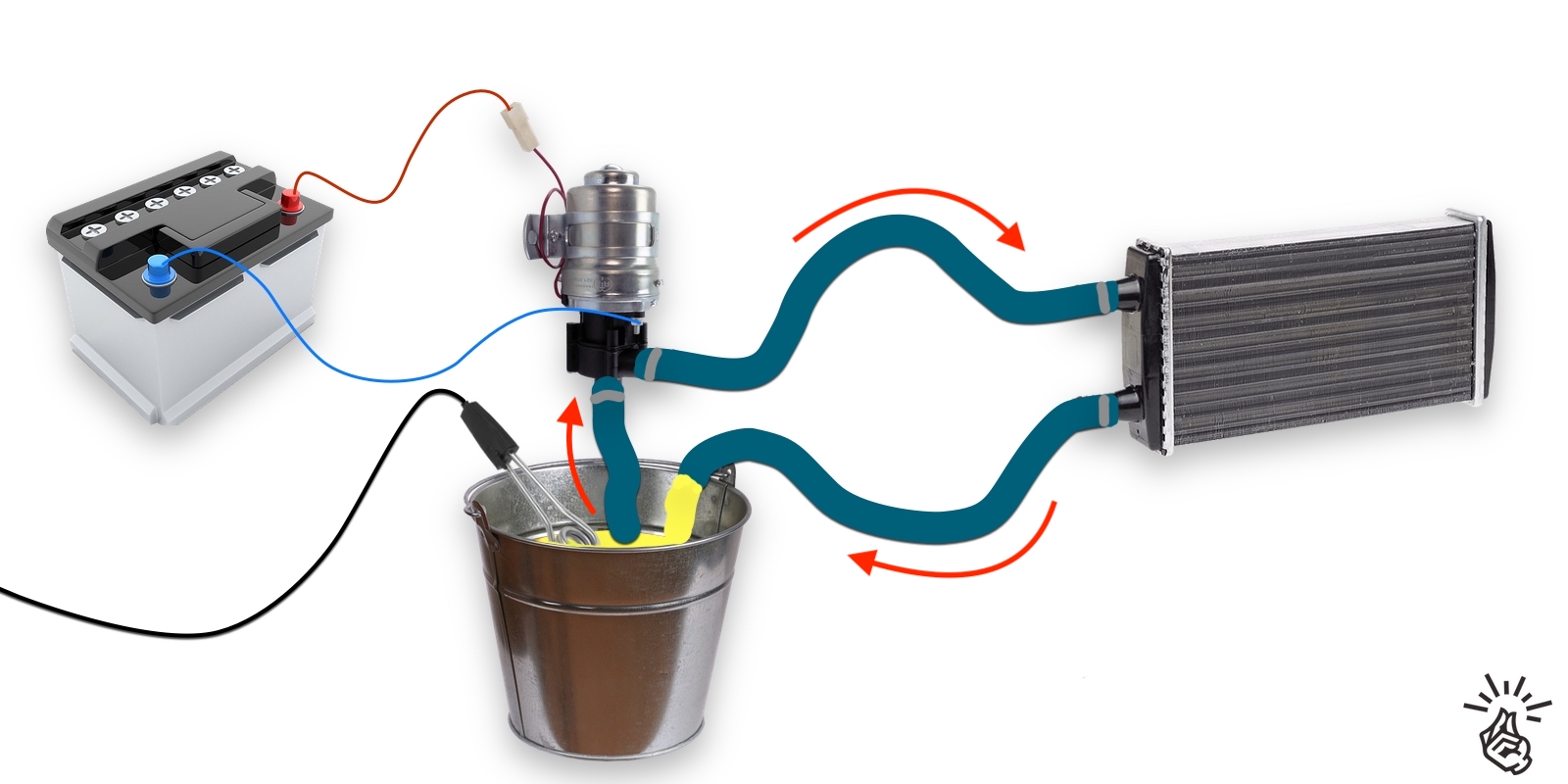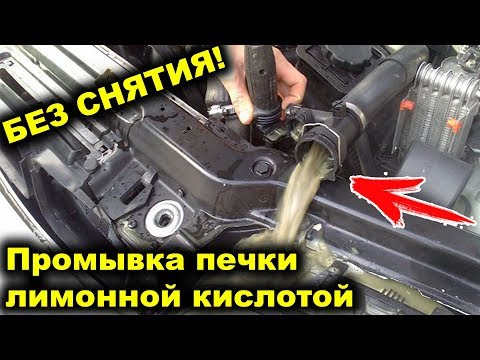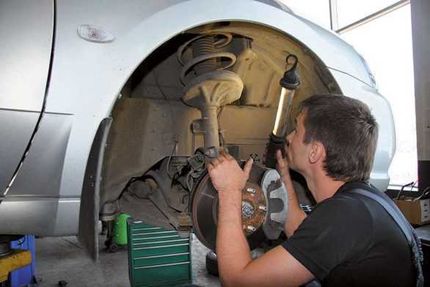
Flushing the stove radiator
Content
- How to understand that the stove radiator is clogged
- How to flush a car heater core
- Than to wash out a radiator of an oven of the car
- F.A.Q.
- What is the best way to wash the copper radiator of the stove?
- What is the best way to clean an aluminum stove radiator?
- How to wash and what are the proportions for washing the stove radiator with citric acid?
- How can I flush the stove radiator without removing it?
- How much does it cost to flush a stove radiator in a service?
Flushing the stove radiator required after approximately 100 thousand kilometers, or if the heater starts to heat poorly. You can flush the radiator, either by dismantling it from the seat, or without dismantling it. When self-rinsing, citric acid, whey, caustic soda, boric or phosphoric acid are usually used, and special tools are used at service stations.
How to understand that the stove radiator is clogged
There can be many reasons why the stove does not heat well ... Including, this happens due to its clogged radiator from the inside with decomposition products of the coolant. To check its purity, it is necessary to check the temperature of the inlet and outlet pipes going to the stove radiator on a warmed-up internal combustion engine. So, if one of them is hot and the other is cold, then the stove radiator is clogged. A blockage in the heater radiator will also be indicated by the fact that both of them are hot but the stove still blows cold air.
Why do oven radiators get clogged?
The cause of a clogged stove radiator lies in the coolant. Firstly, in any antifreeze, over time, spent additives precipitate, and secondly, when the liquid is heated, scale gradually appears, and it can also cause corrosion of the surfaces of all elements of the internal combustion engine cooling system. As a result, all that garbage accumulates in the thin tubes of the honeycombs of the stove radiator. And if the antifreeze or antifreeze is of good quality, then these processes occur very slowly, the liquid is of poor quality, then it’s not like a radiator, an internal combustion engine can be ruined in a couple of years.
How to flush a car heater core

Flushing the stove radiator video
The stove radiator can be washed with or without dismantling. In the latter case, cleaning compounds are usually simply poured into the radiator or driven by an additional pump by connecting to the nozzles, and then washed with water.
Flushing the radiator of the stove without removing
It is easier to rinse the stove radiator without removing it. To do this, use one of three methods - using two plastic bottles, using a large plastic bottle suspended, or using an external water pump. The described methods allow you to create pressure in the radiator, under which the cleaning fluid will circulate inside it.
Flushing with plastic bottles
Flushing the stove radiator with two plastic bottles
The method of flushing with plastic bottles allows you to flush the stove radiator, in two ways - in the removed state and exactly in place from the engine compartment. To work, you need the following tools: two one and a half liter plastic bottles, radiator cleaner, four clamps. The essence of the method lies in the fact that in order for the flushing liquid to be poured half into the radiator and one bottle, they will alternately drive from one bottle to another by pressing the bottles with their hands or feet. this is how the internal cavity is cleaned. The method is very simple and effective. When the liquid is very dirty, it must be replaced with a clean one.
Also, one method is to cut off the bottom of a large plastic bottle (five to six liters), thus creating a watering can from it. And hang it higher, thus creating pressure for the fluid flowing out of it. Connect one hose to the neck and the first radiator pipe, and the second hose to the other radiator pipe and into a bucket on the floor. For tightness, it is advisable to fix the hose on the radiator pipes with clamps.
When flowing from a height, the pressurized cleaning fluid will clean the inside of the radiator. Continue working until the new fluid is clean enough.
Flushing the radiator with a machine pump
One of the most effective methods is to make a device based on an external fluid pump, which constantly circulates detergent inside the stove radiator under pressure.
Flushing the stove radiator with a machine pump. Photo taken from drive2.ru/users/ya-rusich
To make the device, you will need: an electrically driven machine pump, three hoses that match the radiator and pump outlets in diameter, a battery charger, an immersion boiler (which needs to heat the liquid), a solution container, a filter element (synthetic sock or stocking), cleaning composition, a stand for a container with a solution at the level of the pump.
Connect the pump (inlet/outlet), radiator (inlet/outlet pipes) and the basin containing the warm cleaning solution with hoses. Put a filter sock on the end of the outlet hose. Start the pump, from the battery terminals, so that it “drives” the liquid in a circle. And do not forget to connect the charger to the battery, as it is under a lot of stress.
this will turn out a looped system through which the cleaner will circulate through the radiator. It is recommended to “drive” the liquid for an hour in one direction and an hour in the other direction. After that, replace the liquid with a clean one and repeat the procedure again. At the end, rinse the radiator with boiled or distilled water for half an hour in each direction.
All the described methods can also be used if the stove radiator is dismantled from the seat. This will allow not only to clean it under pressure, but also simply by pouring special cleaning products into it. In addition, the additional advantage of dismantling is that the car owner will have the opportunity to remove debris, as well as inspect it for damage and corrosion.
Than to wash out a radiator of an oven of the car
On modern cars, stove radiators are made of two basic materials - copper and aluminum. For aluminum radiators, you need to use acidic products, and for copper - alkaline compounds. Alkaline solutions should not be used to clean aluminum radiators, as its surface will immediately begin to oxidize, and the clogging situation will only worsen or completely ruin the part!
List of products that can be used to clean aluminum and copper stove radiators.
| Means | Radiator type | the need to dismantle the radiator when flushing | |
|---|---|---|---|
| Aluminum | Copper | ||
| Lemon acid | ✓ | ✓ | × |
| Table Vinegar | ✓ | ✓ | × |
| Lactic acid or whey | ✓ | ✓ | × |
| Battery electrolyte | ✓ | ✓ | ✓ |
| Caustic soda | × | ✓ | ✓ |
| Orthophosphoric acid | ✓ | ✓ | ✓ |
| Boiled or distilled water | ✓ | ✓ | × |
| Special professional products | ✓ | ✓ | × |
Flushing the radiator of the stove with citric acid
Using citric acid, you can clean radiators made of any metal, both aluminum and copper. There can also be several proportions and recipes for its use. One of them is to take 20 ... 40 grams of dry acid and dissolve them in one liter of water. If the radiator is heavily clogged, then the amount can be increased to 80 ... 100 grams per liter (increase the volume of the flushing mixture proportionally). Ideally, the acid solution should be tested with litmus paper - pH value should be 3. This is the best composition for cleaning the stove radiator.
The acid solution can be used according to the methods described above, pouring it inside. As an option - pour it into the car instead of antifreeze, and start the internal combustion engine for 30 ... 40 minutes, letting it idle or ride, and then leave it overnight. Then drain the liquid, if it is very dirty (with a lot of sediment), the procedure should also be repeated one or two times. After that, flush the cooling system with plain distilled water and fill in new antifreeze.
Vinegar flush
Acetic acid is also one affordable and effective cleaning agent for both the cooling system in general and the stove radiator in particular. To prepare the washing solution, you will need 500 ml of table vinegar, which must be diluted in 10 liters of boiled or distilled water. The rest can be done by analogy with washing with citric acid. This composition is suitable for radiators made of both copper and aluminum.
Serum wash
Flushing the stove radiator with whey
Lactic acid that is in the whey perfectly washes plaque, rust, debris from the walls of both aluminum and copper radiators. However, it is quite difficult to find lactic acid in its pure form, so the easiest way is to use natural (this is very important !!!) whey.
To clean the stove radiator, it needs 5 ... 10 liters. Before using the serum, you need to strain it through a filter a couple of times in order to remove pieces of fat from it!
Most often, it is poured into the system and ridden for about half an hour, and then drained and washed with hot distilled water several times, since whey contains fat.
Flushing the stove radiator with electrolyte
The battery electrolyte also washes well various deposits and plaque. You can use almost any electrolyte in sufficient volume. With it, you can clean both copper and aluminum radiators (however, not for very long!). When working with electrolyte, be sure to wear work clothes, rubber gloves, a respirator and goggles.
Having removed the radiator, the electrolyte is poured into it to the eyeballs and left for a couple of hours in order for a chemical reaction to occur, in which dirt and plaque will dissolve. Then drained and washed. Only the first time the water used should be with a small amount of baking soda (1 tablespoon per liter). And then it is desirable to use a cyclic "run" of water through the insides of the radiator.
Washing with caustic soda
Caustic soda - caustic alkali, may have several names, caustic soda, sodium hydroxide, caustic. With her help you can’t clean aluminum radiators, only copper ones and, moreover, by removing them from the car, because it adversely affects the aluminum parts of the cooling system.
And to clean the radiator, use a 10% sodium hydroxide solution. In its manufacture, personal protective equipment is needed, because if it comes into contact with the skin, the caustic can cause a chemical burn. The resulting solution must be heated before use, and then poured and left for several hours, then drained. If necessary, repeat the procedure two or three times until the poured liquid is relatively clean. At the end, be sure to rinse the radiator with clean boiled or distilled water.
How to flush with phosphoric acid
Orthophosphoric acid, or rather its 85% solution, sold in specialized stores, is also well suited for cleaning aluminum and copper heater radiators. It is used on radiators removed from cars. You need to work in personal protective equipment, gloves, a respirator.
The acid just needs to be poured into the radiator and left there for a couple of hours. After that, rinse thoroughly with boiled or distilled water. It does not corrode the metal, but instead dissolves the plaque and rust formed inside.
Rinsing with water
The simplest, but the most ineffective remedy is ordinary boiled (this is important !!!) or distilled water. However, if you want to simply flush the radiator with water, then this must be done under pressure. In its pure form, it is usually not used, but only as a rinse after some of the products.
Special tool for washing the stove radiator
For those who do not trust the folk “old-fashioned methods”, auto chemical manufacturers have made ready-made products that are specifically designed to clean the car’s cooling system.
Popular remedy LIQUI MOLY Kuhler-Reiniger
- LAVR Radiator Flush Classic. Can be used to flush radiators made of both aluminum and copper. Sold in jars of 430 ml and 980 ml. A small can is designed for a cooling system volume of 8 ... 10 liters. Therefore, its quantity must be calculated in accordance with the volume of the radiator. Instructions are on the package. It is noted that the tool perfectly removes rust, limescale, dirt and other debris. The price of one small can as of the summer of 2020 is about 400 rubles.
- LIQUI MOLY radiator cleaner. The tool is also designed to clean the cooling system. Can be used to clean radiators made of any metal. Well removes rust, plaque, debris. sold in a 300 ml metal can, which is designed for a 10 liter cooling system. It costs about 625 rubles.
- Hi-Gear Radiator Flush. Distinctive feature of washing — carries out cleaning within seven minutes. Can be used to clean any aluminum or copper radiators. One can of 325 ml is designed for 17 liters. The price is about 290 rubles.
F.A.Q.
What is the best way to wash the copper radiator of the stove?
The simplest method for flushing a copper car heater radiator is to use a 10 percent caustic soda solution (caustic soda, mole for flushing plumbing pipes). The hot solution is poured inside for 30 minutes, then drained. If necessary, repeat the procedure two or three times. Washing with a mixture of citric acid and vinegar also shows good results. However, for an old copper radiator, it would be best to remove it, unsolder it and mechanically clean it by hand.
What is the best way to clean an aluminum stove radiator?
For washing aluminum radiators of stoves, it is recommended to use acid-based products. The best options are whey, citric acid (such mixtures should only be very hot - 90 ° C) or a solution of phosphoric acid (heated to 40-50 degrees). And for a copper-brass heat exchanger, only professional products designed to flush the car cooling system will be safe.
How to wash and what are the proportions for washing the stove radiator with citric acid?
The proportion for flushing the radiator of a machine stove with citric acid is 50 grams of acid per five liters of water. If the radiator is heavily clogged, the amount of acid can be increased to 80 grams. The acid is poured into 0,5 liters of boiled water, stirred until dissolved and then a basic volume of distilled water is added. The liquid is poured into the cooling system instead of antifreeze, the internal combustion engine is warmed up to operating temperature, and then also left to idle for 15 minutes. Then drain and wash the system 3-4 times with distilled water.
How can I flush the stove radiator without removing it?
Alkaline, acid or special cleaners are used to flush the radiators of the car interior heater. Alkaline compounds remove scale (lime), and acidic compounds remove rust.
How much does it cost to flush a stove radiator in a service?
you need to understand that different services, including in different cities, may charge different prices for the service of cleaning the stove radiator without dismantling it. However, as of the summer of 2020, on average, the price of this procedure starts from 1500 Russian rubles. As for the duration of the procedure, it is about two hours. If the radiator is heavily clogged, it may take more time and the pay will increase as more cleaners and workers time will be wasted.
